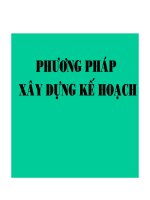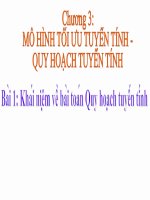Bài giảng chương 3 - QUALITATIVE RESEARCH - Phương pháp nghiên cứu khoa học
Bạn đang xem bản rút gọn của tài liệu. Xem và tải ngay bản đầy đủ của tài liệu tại đây (150.3 KB, 19 trang )
28/05/14
28/05/14
1
1
CHAPTER 3
CHAPTER 3
QUALITATIVE RESEARCH
QUALITATIVE RESEARCH
Contents…
Contents…
1. Definition & Characteristics
2. Qualitative vs. Quantitative research
3. Qualitative data collection
4. Qualitative data analysis
28/05/14
28/05/14
2
2
I . DEFINITION:
Qualitative research includes an “array of
interpretive techniques which seek to describe,
decode, translate, and otherwise come to terms
with the meaning, not the frequency, of certain
more or less naturally occurring phenomena in
the social world.”
28/05/14
28/05/14
3
3
•
Aims to achieve an in-depth understanding of a
situation.
•
Ideal for extracting feelings, emotions, motivations,
perceptions, consumer “language,” or self-described
behavior.
•
Example: Why a person entering a grocery store
proceeds down each aisle in turn, or heads for the
rear of the store.
28/05/14
28/05/14
4
4
Qualitative Research
•
Data presented in words, pictures, etc.
•
May be subjective/ susceptible to human error/
bias in data collection/ interpretation.
•
Results cannot be generalized
a fundamental weakness.
28/05/14
28/05/14
5
5
II. QUALITATIVE QUANTITATIVE
Theory
Testing
Theory
Building
•
Understanding
•
Interpretation
•
How / Why
•
Texts; detailed descriptions
of events, situations, and
interactions (verbal/visual).
•
Description
•
Explanation
•
What/ How many/ When
•
Data are coded, categorized,
and reduced to numbers for
statistical analysis.
28/05/14
28/05/14
6
6
III.1. Sampling
& Sample size
Purposive
Sampling
Snowball
Sampling
Convenience
Sampling
Small Sample Size
General rule:
You should keep conducting interviews until no
new insights are gained.
III. QUALITATIVE DATA COLLECTION
28/05/14
28/05/14
7
7
Focus Groups
III.2. Qualitative data collection techniques
Ethnography
Ethnography
Observation
Observation
Data
Collection
Techniques
Data
Collection
Techniques
Individual
interviews (IDIs)
Individual
interviews (IDIs)
Case Studies
Action
Research
Grounded
Theory
Group
Interviews
28/05/14
28/05/14
8
8
III.2.1. Individual depth interview (IDI) :
•
Best used for “How, Why” questions or “Story telling”
, “Feeling” questions
•
Exploratory stage
•
Can be unstructured, semi-structured or structured
•
From broad issue to narrow topic
•
Face-to-face or via telephone/online
•
Situational / personal bias
28/05/14
28/05/14
9
9
•
Dyads (2)
•
Triads (3)
•
Mini-Groups (3-6)
•
Focus Groups (6-10)
•
Supergroups (10-20)
III.2.2. Group interviews
28/05/14
28/05/14
10
10
Focus group interview
•
Typically consists of 6-10 members + a moderators
leading the discussion on a particular topic
•
Used for exploratory studies/generating ideas
•
Unstructured / Natural / Flexible
•
May be biased by leading opinions
May be biased by leading opinions
•
Important role of the moderator
Important role of the moderator
28/05/14
28/05/14
11
11
Individual Interview Focus Group Interview
Research Objective
•
Explore life of individual in depth
•
Create case histories through
repeated interviews over time
•
Test a survey
•
Orient the researcher to a field of
inquiry and the language of the field
•
Explore a range of attitudes, opinions,
and behaviors
•
Observe a process of consensus and
disagreement
Topic Concerns
•
Detailed individual experiences,
choices, biographies
•
Sensitive issues that might provoke
anxiety
•
Issues of public interest or common
concern
•
Issues where little is known or of a
hypothetical nature
Participants
•
Time-pressed participants or those
difficult to recruit (e.g., elite or high-
status participants)
•
Participants with sufficient language
skills (e.g., those older than seven)
•
Participants whose distinctions would
inhibit participation
•
Participants whose backgrounds are
similar or not so dissimilar as to
generate conflict or discomfort
•
Participants who can articulate their
ideas
•
Participants who offer a range of
positions on issues
28/05/14
28/05/14
12
12
Interviewer / moderator qualifications
Requires training or experience.
Skills include:
•
Making respondents comfortable
•
Probing without making the respondent feel harassed
•
Remaining neutral while encouraging participants to talk openly
•
Following a participant’s flow of thought
•
Extracting insights from detailed descriptive dialogue
Use their personal similarities / differences :
•
Similarities to convey sympathy and understanding
•
Differences to demonstrate eagerness to understand.
28/05/14
28/05/14
13
13
III.2.3.Case study method
•
Combining Interviews + record analysis + observations.
•
To obtain multiple perspectives of a single organization,
situation, event, or process.
•
What differences occur, why, how and with what effect.
•
Specific organizations/situations are selected because
they offer critical, extreme, or unusual cases.
•
Choose multiple subjects to study for cross-case analysis.
•
Choose participants from different org. levels, or different
perspectives of the same situation or process.
28/05/14
28/05/14
14
14
IV.
IV. QUALITATIVE DATA ANALYSIS
1. QUALITATIVE vs. QUANTITATIVE ANALYSIS
Similarities Differences
Using reasoning to infer empirical
data to abstract concept/theory
Quali. data analysis is less
standardized/more flexible
Applying public method/procedure
Quali. data analysis begins early in
the process, while still collecting
data (until saturation)
Comparing similarities/differences
is the central process
Quali. data analysis creates new
concepts/theory; not test them
Avoiding errors, false conclusions,
misleading inferences
Quali. data analysis is closer to raw
data/ less abstract, less precise,
context-based, more-than-one
meaning
28/05/14
28/05/14
15
15
IV.
IV. QUALITATIVE DATA ANALYSIS
2. THREE BASIC PROCEDURE:
Description – Classification - Connection
•
Step 1: Phenomenon description
Purpose: to form/create concepts
Technique: open coding
Guide:
+ Retrieve abstract concepts from concrete raw data
+ Locate themes & assign initial codes/labels to pieces of
raw data bearing the same meanings
+ Condense mass data into codes/concepts
+ Theoretical framework may help
+ Open to change / flexible manner / back and forth
28/05/14
28/05/14
16
16
IV.
IV. QUALITATIVE DATA ANALYSIS
2. THREE BASIC PROCEDURE:
Description – Classification - Connection
•
Step 2: Phenomenon classification
Purpose: to classify codes/concepts into categories
Technique: axial coding
Guide:
+ Focus to work on codes/concepts created in step 1
+ Combine several closely related concepts in to more general one
by organizing them around the axis of key concepts (categories)
based on similar/different attributes
+ Each axis represents a category or new concepts at higher
abstract level.
28/05/14
28/05/14
17
17
IV.
IV. QUALITATIVE DATA ANALYSIS
2. THREE BASIC PROCEDURE:
Description – Calssification - Connection
•
Step 3: Concepts connection
Purpose: to identify possible relationships among concepts to
form a logical system (i.e. theory)
Technique: selective coding
Guide:
+ Connect concepts / arrange them into sequences
+ Compare/contrast to identfy possible relations
+ Form overall connections among concepts
28/05/14
28/05/14
18
18
Our Practice Project
Learning Effectiveness
• Use
group discussion to collect qualitative data
group discussion to collect qualitative data
•
Analyze qualitative data and develop the model
Analyze qualitative data and develop the model
reflecting
reflecting
“determinants of learning performances”
“determinants of learning performances”
• Present your results
28/05/14
28/05/14
19
19
End session 5
End session 5









